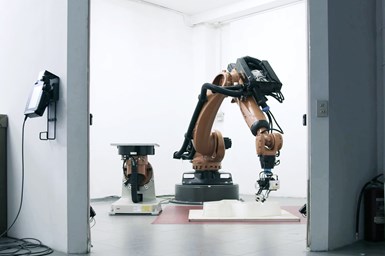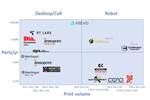Moi Composites debuts 3D-printed glass fiber boat
Moi used its patented CFM 3D printing technology for depositing continuous fibers impregnated with thermosetting resin to develop MAMBO’s unique design.

Photo Credit: Moi Composites
Moi Composites Srl. (Moi; Milan, Italy) revealed on Sept. 28 its MAMBO (Motor Additive Manufacturing BOat) project, a 3D-printed boat using a continuous glass fiber thermoset composites. The boat was officially launched and displayed at the 2020 Genova Boat Show October 1-6, 2020, to welcome its audience to the company says is the next generation of boat design and manufacturing.
Developed via Moi’s patented Continuous Fiber Manfacturing (CFM) 3D printing technology, the company notes that the system’s rare capability to 3D print continuous glass fiber thermoset material enabled MAMBO’s unique design, ultra-durability and scalability in print size. The CFM technology involves the use of robotic machines, capable of depositing continuous fibers impregnated with thermosetting resin for optimized performance, starting from a 3D model of the object. According to Moi, this allows the creation of fiber-reinforced products with mechanical characteristics comparable to those of unidirectional glass fiber, without the aid of models, molds and other tooling equipment. In this way, Moi adds, it is possible to obtain not only prototypes, but real products in small lots or unique pieces, efficiently and cost-effectively.
“We participated in the Genoa boat show in 2017, and it was during this event that we came up with the idea of making MAMBO. We saw the project take shape first, then brought it to life, and finally MAMBO arrived today [Sept. 28] at the sea. All this would not have happened without the support of our partners, who believed with us in this ambitious project,” says Gabriele Natale, CEO and co-founder of Moi Composites.

MAMBO spans 6.5 meters long by 2.5 meters wide, has a dry weight of approximately 800 kilograms, and is equipped with a navigation system, cork flooring, white leather seats and 115 horsepower (hp) engine. MAMBO’s hull is an inverted tricycle inspired by the famous Arcidiavolo by Sonny Levi, on which organic forms chase each other and are transformed into structural and functional elements.
Moi says the various sections were printed using two KUKA Quantec High Accuracy robots in Milan, at Moi Composites’ headquarters and in Autodesk's AMF (Advanced Manufacturing Facility) in Birmingham, United Kingdom. The printed pieces were joined and laminated at Catmarine shipyard, creating a one-piece sandwich structure, without hull-deck division. Moi’s partners in the MAMBO project include a team of global experts in automation, composite materials, and the nautical industry: Autodesk, Catmarine, Confindustria Nautica, Mercury Marine, MICAD, Osculati and Owens Corning.
Related Content
-
Eaton developing carbon-reinforced PEKK to replace aluminum in aircraft air ducts
3D printable material will meet ESD, flammability and other requirements to allow for flexible manufacturing of ducts, without tooling needed today.
-
The next evolution in AFP
Automated fiber placement develops into more compact, flexible, modular and digitized systems with multi-material and process capabilities.
-
Reinforcing hollow, 3D printed parts with continuous fiber composites
Spanish startup Reinforce3D’s continuous fiber injection process (CFIP) involves injection of fibers and liquid resin into hollow parts made from any material. Potential applications include sporting goods, aerospace and automotive components, and more.
















